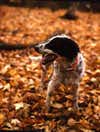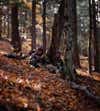Confessions of a Turkey-Dog Addict

Hunting Turkeys with Dogs
My turkey-dogging problem began innocently enough with an invitation from Quaker Boy Game Calls’ Dave Streb to hunt at Turkey Trot Acres Lodge in Candor, N.Y., the country’s only lodge that offers turkey hunts with dogs. Fresh off a weekend of traditional-“and frustrating-“fall turkey hunting at our club in New York’s Catskills, my hunting partner Ralph Stuart and I jumped at the chance. Streb, Turkey Trot’s owner Pete Clare, and John Byrne’s son, J.T., were waiting for us on the porch. “Get your crap on and let’s go,-¿ Streb said. “We’ve got a flock located and we need to go now.-¿ He wasn’t lying. We got to the field where the group had seen the flock feeding and loosed the dogs. Just 20 yards from the tailgate, Aggie and Shot, two black-and-white, setter-looking dogs, picked up the scent and rocketed into the woods. Within moments came the sounds of frenetic barking followed by scattering turkeys-“they seemed to be everywhere before I could even gain my bearings. Not wanting to shoot a bird on the wing (the game isn’t played that way), we watched turkeys run and fly past us. “Can someone please explain to me what the hell is going on?-¿ I asked. “It’s actually pretty simple,-¿ Clare responded. “We get to where we heard the dogs bark. That’s the break site, and fall turkeys will almost always return to that exact spot. If it’s a family flock of hens and this year’s poults, they’ll come back within a couple of hours. A gobbler flock will come back as well, but it could take a day or two. What we’ll do is find some setup trees, zip the dogs into camouflage bags, and wait until we hear birds. Once they start, we imitate what they do and call them in.-¿ I was skeptical that they’d be back to this same spot. But only half an hour after we set up, birds began to talk. Both Streb and Clare used boat-paddle box calls to imitate a dominant hen assembly-yelping to her poults somewhere in the distance. From the high-pitched kee kees approaching our setup, a turkey was buying into the ruse. I risked a look to my left to see Stuart bearing down on his shotgun bead. Out ahead of his barrel stood the source of the whistling kee kees. He dumped the bird at 30 yards. At the shot, the dogs leaped from their camouflage sacks and were on the downed turkey in midflop. Streb held me back and told me that I was next. Streb picked up his calling pace, never missing a beat. Another distant hen mimicked his calls. The report of Stuart’s shotgun obviously had no lasting effect on the regrouping turkeys. “Get your gun up,-¿ he whispered. The 25-yard chip shot was too easy for even me to miss. As we collected turkeys, dogs, camo sacks, and stories, we walked off that hillside serenaded by the kee kees and yelps of the remaining members of the flock. It was an afternoon that changed my autumn days in the woods forever.

Hunting Turkeys with Dogs
fall turkey hunting with dogs has a long history in Appalachia, especially in the hills of Virginia, and no one knows more about it than Virginia cattle farmer John Byrne. His quest for the perfect turkey dog began more than 30 years ago. “I’ve been breeding cows all my life, and the principles are the same,-¿ Byrne says. “You compound the genetic qualities that you want, eliminate the genetic qualities that you don’t want, and with patience and perseverance, sometimes you arrive at where you want to be. For turkeys, you want dogs that will trail and bust flocks-“but above all bark on the break.-¿ A cast-off Plott hound bitch started Byrne’s journey. “One day while I was running Inky, I saw her put her nose to the ground tracking turkeys across some Virginia ridges, putting birds in the air as she went,-¿ he explains. “I bred her with a lemon-and-white pointer, and we got four dogs out of it-“one female and three males. The female, Sue, was the only one who showed any promise. We then bred her to a English setter, a field-trial dog named Jack.-¿ Jack proved to be the next piece to the turkey-dog puzzle. “Nobody could make him point and they were going to get rid of him, so I asked for the dog,-¿ says Byrne. “The first flock of turkeys he got after, he busted. I bred Sue to Jack and got Junior-“we were in business.-¿ Junior, the one-quarter Plott, one-quarter pointer, and one-half setter cross, was bred to a number of dogs, and the rest is turkey-dogging lore. Today Byrne dogs are seen by many to be the best in the fall woods. Whereas schooling a typical bird dog involves painstaking and often expensive work, training turkey dogs-“or at least Byrne dogs-“doesn’t take all that much. I’ve hunted with my Byrne dog, Jake, for nine seasons. “You just need to give him access to turkeys,-¿ Byrne told me. “Just let him get his nostrils full of turkey scent, then let the genetics kick in.-¿ That very mid-January afternoon, I opened the front door of my hunting camp to see four gobblers standing in the driveway. The toms high-stepped toward the woods through a foot of freshly fallen snow and were out of sight within seconds. Heeding Byrne’s advice, I opened the door again to let Jake scent them. I’ll never forget the sight of that pup plowing his way through the powder in an effort to catch up. He never did, nor did he ever quit. After following Jake for several hundred yards, I picked him up and brought the exhausted little guy back to camp, where he slept next to the woodstove for the night. Jake’s determination astounded me.

Hunting Turkeys with Dogs
Fall turkeys generally break up into two flock types: family groups of hens and poults, and bachelor gobbler flocks. They’re all in full survival mode. Outsmarting them is as much knowing the woods, reading sign, and following the food as it is calling. Find a critical food supply and you will find the birds. In farm country, that means corn and soybeans. Mast-“both hard (acorns and beechnuts) and soft (wild black cherries and autumn olive)-“is a favorite among hill dwellers. Bugs, too, are a mainstay for flocks. I usually hit the woods by 8 or 9 A.M., heading directly for the best food sources. The key to turkey-dogging is to exploit the dogs’ sensitive noses, so allowing the birds to spend a couple of hours off the roost-“spreading ground scent while they forage-“is a big advantage.

Hunting Turkeys with Dogs
Hunting Turkeys with Dogs
When you set up on a busted flock, you’re likely to hear virtually every sound a turkey can make. The rule for calling is simple: Imitate what you hear. If an adult hen yelps in the distance, do what she does. Gobbler yelping should likewise be replicated (but prepare yourself for a longer wait). Unlike spring hunting, don’t be afraid of overcalling. Dispersed turkeys vocalize loud and often, and so should you.-“G.B.